Podcast: Play in new window | Download (Duration: 34:34 — 39.4MB)
Subscribe: Apple Podcasts | Spotify | Amazon Music | Android | Pandora | iHeartRadio | JioSaavn | Podcast Index | Email | TuneIn | RSS | More
By Davy Crockett


Both a podcast episode and a full article
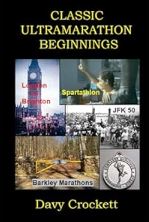

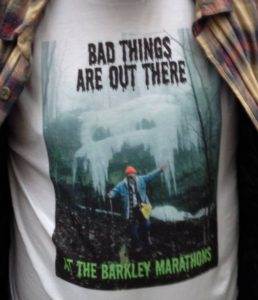 The Barkley Marathons, the toughest trail race in the world, is held in and near Frozen Head State Park in Tennessee, with a distance of more than 100 miles. The first year it was held was in 1986, and it is now world famous. Only 40 runners are selected to run.
The Barkley Marathons, the toughest trail race in the world, is held in and near Frozen Head State Park in Tennessee, with a distance of more than 100 miles. The first year it was held was in 1986, and it is now world famous. Only 40 runners are selected to run.
Barkley is the brainchild of Gary Cantrell (Lazarus Lake) and Karl Henn (Raw Dog). In 1985, they had been intrigued by the very few miles that James Earl Ray had covered back in 1977 during his 54.5-hour prison escape in the mountains. Cantrell felt that he could do much better. See Barkley Marathons – The Birth
That year Cantrell and Henn went up into that wilderness to backpack, in two days, the “boundary trail,” about 20 miles, constructed by the Civilian Conservation Corps decades earlier. Four people died building the trail. When they showed the rangers their route around the park, they were told that they wouldn’t be able to make it. The rangers didn’t want them to go on the hike because they didn’t want to have to rescue them. But the rangers were convinced to give them a permit. The first 7.5 miles took the two ten hours to cover.
They did finish their backpack trip and told the rangers that they had some friends who would probably like to run the trail. The idea for Barkley had been hatched and a course was designed and plans put into place for the first year of the Barkley in 1986 at Frozen Head State Park. Cantrell later said, “The best description of the course I’ve heard? Someone told me that every ultra has its signature hill, the nasty one that’s totally unreasonable and makes or breaks the race—the Barkley is like all those hills just put end on end.”
Frozen Head State Park


In 1933, the Tennessee Governor set aside a large portion of the Brushy Mountain State Prison’s lands to establish the Morgan State Forest. That year the Civilian Conservation Corps came and constructed roads, facilities, and some trails that Barkley uses today including the Boundary Trail. The CCC worked for multiple years. Rattlesnakes and all the prison escapes taking place every year made it difficult to establish a camp in the forest until 1938. In 1952 a large portion of the forest was burned and prison inmates were used to fight the fire. In about 1970 the Frozen Head State Park was established.
One of the unknown heroes of the Barkley is Don Todd (1918-2005) of Wartburg, Tennessee. He was active since the 1960s in an effort to protect the area that became Frozen Head State Park. Since the 60s he led wildflower-spotting hikes within the park to acquaint others with its diversity of plants and animals.
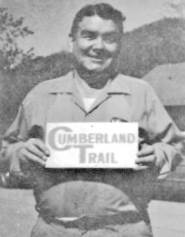

Todd pushed to have nine square miles around Frozen Head declared unsuitable for coal mining and helped stop plans for a huge strip mine on Frozen Head which would have been visible from 80% of the trails within the park. Thankfully that didn’t happen and Todd was proud that the park looks pretty much the way it did when “the first white men came.” He said, ”it’s something I put value on trying to improve the quality of life in the mountains a little bit. In 1985 he was awarded the Gulf Conservation Award for his efforts.
Coal strip mining was a constant worry for the area. In 1971 a coordinated effort gathered petitions and fought to not allow state land close to the park to be sold off to potential strip miners. In 1973 a state bill was introduced to prevent strip-mining of 2,500 acres of coal land near Frozen Head. But strip mining was a constant threat to the park.
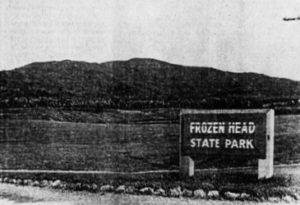

Also, in 1978 another prison was planned to be built right near the entrance to Frozen Head State Park where a prison “Honor Farm” had existed. It would have been a $7.5 million 400-bed structure. A citizen’s group filed a suit against the plans stating it would impede development of an environmental education center planned nearby. The Frozen Head State Park Association also joined in the suit. The suit was dismissed by Judge Ben Cantrell but it was also found that the Correction Department officials did not use proper guidelines for selecting the site.
Barkley, The First Year – 1986
In 1986 Gary Cantrell, now a veteran runner of more than 50 ultras co-created the Barkley Marathons with Karl Henn (Raw Dog.) The grueling event with unsuspecting runners was held for the first time on March, 1, 1986. The race was named after one of Cantrell’s early running partners, Barry Barkley. Cantrell said, “Barry was injured in Vietnam, so he can’t run, but he’s always been enthusiastic about the sport. He came once back in the 80s, but he’s a farmer, and spring is planting season. He keeps saying one day he’ll retire and come see it.”
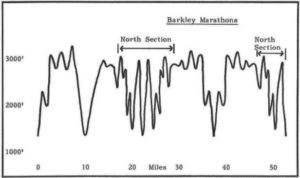

Thirteen unlucky runners started that first year, including Cantrell. They paid the entry fee of 35 cents. Three runners arriving late, were the luckiest. During the first hour before dawn they went up the wrong mountain (Frozen Head) and soon were out. After 12.5 miles, the remaining eight started to tackle the very difficult North Section. Cantrell explained, “It is poorly marked, severely eroded, over-grown, and laced with deadfalls.”
Cantrell remembered, “There were places where you would come to a pile of tree trunks. Me and Gary Buffington came to one and we were trying to figure out how to get across. It was on such a steep hill side. I then had an idea. I told Gary to give me his pack for a second and he gave me his pack and I threw it over the top of the trees onto the trail on the other side. I then took my pack and threw it over there too. I said, ‘Now we have to get there!’ We got across.”
Two thrashed runners completed the first 20-mile loop in under nine hours but were wise and chose to quit. Three “fortunate” runners got lost and took an easy way out on the “quitters” jeep road and headed for home before completing the loop. These included Doyle Carpenter and Fred Pilon, who ran together. But on the North Boundary Trail, they got lost after Jury Ridge which was about three quarters around the loop.
Three remained. Buffington and Cantrell finished the first loop in 12:18, and called it quits. They were probably the only ones who ran the loop correctly. Only Damon Douglas continued on, reaching 35-37 miles in 17:08. He knew he couldn’t finish the last 20 miles by the 24-hour cut-off and called it quits. So there were no finishers that first year and Cantrell called it “a rousing success all around.” The participants believed that the course was much longer than claimed. Historian Nick Marshall who knew Cantrell wrote that he was a “devious trickster.” In his Ultrarunning Magazine report Cantrell wrote, “Of course it is still impossible to run 50 miles on a trail in a day, but if anyone wants to try, we’ll be doing it again next spring.”
Cantrell was a regular columnist for the Ultrarunner Magazine, writing a column “From the South.” In his writings he revealed his philosophies about running and the sport. Even though he was a serious runner, and loved the sport, he put it all in perspective. For example, in 1986 he wrote, “I do believe our sport is good for us, the participants. However, it really doesn’t contribute anything significant to mankind. Some say we are exploring man’s limits. I think we are only exploring our own.” Given all the problems in the world “how far a man can run in 24 hours is hardly a burning question.” He knew that Barkley wouldn’t cure any world problems, but he could never foresee that in the decades to come tens of thousands would receive intense inspiration from the race that eats its young.
1987 Barkley
At various races, Cantrell spread the news of his new race and tried to convince runners to come give it a try. Sixteen unwise runners showed up for the second year in 1987 to run what one returning runner described as, “Gary Cantrell’s excuse for a trail run.” The first woman runner started, Linda Sledge. Entry was a lot easier in those early years. You simply called or wrote to Cantrell. His contact information was published in the newspapers. But the entry fee was increased significantly to 50 cents, a penny for each mile. Cantrell offered a “full refund if you stick it out and have a cubic inch of your body not in extreme pain.”
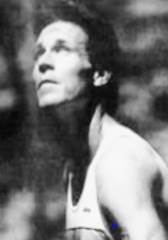

Tom Possert entered the 1987 Barley and all eyes (the very few at Frozen Head Park) were on Possert. He was from Cincinnati, Ohio. When Possert was 14, he and his friends would go on 100-mile bike rides. He ran track in high school but quit because he didn’t like getting lapped. After he graduated from high school he rode his bike all the way across the country. In college he took up running to get into shape and discovered the further the distance, the more competitive he became.
Possert ran his first ultra in 1984 and among the first races was the 100K at 1984 AMJA Ultra road race in Chicago. He ran a speedy 8:43. Next he started his long career with fixed-time races at Across the Years 24-hour race in Arizona. A fellow runner commented about Possert in that race. “Tom Possert was walking strongly. He’s tall and thin, with a fine walking stride. It was amusing to watch him stride past those of us trying to run.” Possert won with 124 miles which was the best 24-hour performance that year by an American.
The next year, in 1985, he ran JFK 50 and finished in 18th in 7:40. In 1986 he finished 4th at American River 50 with 6:29. That year he also ran 147 miles at Across the Years with was the 5th furthest for an American in the modern era of ultrarunning. People thought Possert was certainly a serious contender to finish the 50-mile Barkley.
1987 Race Details
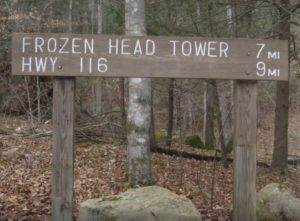

The course that year consisted of three 16.67-mile loops with a 36-hour cutoff. Pre-race chatter among the dozen runners involved being intimidated by the terrain and talking about James Earl Ray’s escape from prison and his suffering in the hills.
Soon after the 6 a.m. start, Possert and another runner took the lead. The field included six marines, led by Sergeant Stone, with backpacks, canteens, and heavy boots. (The marines that year watched from a ledge, a wolf pulling down a deer.) These marines had previously marched the JFK 50 and believed they would certainly finish Barkley. Stone told his men that if they didn’t finish, they would get extra duty. First up was climbing switchbacks up to the top of Bird Mountain.
Fred Pilon
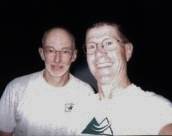

Fred Pilon, of Massachusetts, was an experienced race director who owned a runner’s shop. He was a co-editor for Ultrarunning Magazine and also was an early veteran of mountain 100-milers. He had finished Old Dominion 100 twice, in 1979 and 1980 and Wasatch 100 in 1983. He had also competed in orienteering contests but those skills had not helped him enough when he attempted Barkley the first year when he went off trail.
Pilon again returned in 1987 for more punishment. After several miles, he caught up with Possert and another runner in the lead, and they all worked together for a while, trying to not get lost. When they hit the new section, it first went down New River Valley and paralleled the river to the base of Frozen Head. They believed that no one had ever been there before.
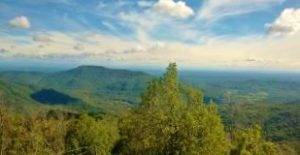

Pilon wrote, “The top of the valley was guarded by dense stands of briars, blown-down trees, huge boulders, and numerous cliffs.” They couldn’t find the trail that supposedly was built in 1941, but never used. Once at the base of Frozen Head, they found no trail heading up, so they just bushwhacked up. Along the way they passed “numerous seams of coal, old wells, wheels and pulleys of all sorts, and a cave (mine).” It took them two hours to reach the top of Frozen Head. Others took four hours and couldn’t find much of a trail either. It was believed that inmates from the prison used the long-forgotten trail to reach a coal mine years before. (See Barkley Marathons – The Birth).
With all the struggles, Pilon reflected on the spirit of Barkley that is still true years later. “All of this creates the charm, or curse, of Barkley. You are on you own, away from civilization for hour after hour, with only the occasional wild animal or bird to welcome as another moving object. The wildflowers, trees, clouds, and the silhouettes of the hills compete for your attention. But we carry along our internal set of images, desires, thoughts, and hopes that pride another set of challenges to overcome, adding pressure beyond the mere physical act of trying to run the race.”
1987 Barkley Course Wins
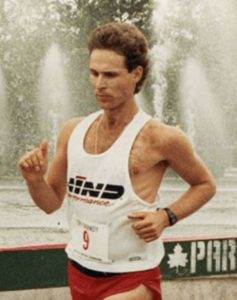

Possert and Pilon completed the first 16.7-mile loop in 7 hours. They headed out for loop 2, wondering if they could follow the trail once it became dark. Possert went on ahead once Pilon knew he couldn’t keep up. Halfway through the loop during the afternoon, before the most difficult New River Valley section, Possert stopped, rested, ate, and slept until Pilon caught up. He asked, “Do you plan to go through Hell again?” They both declined, knowing that no one would make it through that section twice.
The two of them enjoyed the much easier “loser run” back to the start, reaching there in 14:30, and felt OK with their decision to quit. The course won once again. No runners finished. Possert finished with bad blisters and his legs were badly chafed from using tights. Pilon was dehydrated and had a badly sore Achilles tendon. They found out that elite runner Mac Williamson had shown up to the race late and completed the first loop in only five hours. But he had never passed them and they doubted he went the right way. It didn’t matter because he quit too.
Cantrell also finished a loop but his time is unknown. The marines didn’t make it all the way and were worried about the extra duty that they would have to perform. They did make it through “Hell” up to the top of Frozen Head. Linda Sledge was hiking near them and found some deer antlers. She conned a polite marine to haul it to the top of Frozen Head for her. Some runners hoped to return the next year but knew “Gary will change the course, find some more hills, discover more undiscovered trails.”
The Brushy Mountain Prison below Frozen Head was still a violent place. A prisoner, E. Scott McHenry, arrived later that year and in October was beaten by guards for two days. He successfully sued them for “unconstitutional, cruel and inhuman punishment and was awarded by a jury $2,600 which was upheld by a federal appeals court.
1988 Barkley


Nineteen brave, but foolish, runners came in 1988, including eleven newcomers (later called virgins). The entry form that year was entitled, “The Barkley Marathons, the race that eats its young.” Entry that year introduced a requirement that each runner write an essay on why they should be allowed to enter. In his letter to the entrants Cantrell wrote, “There is no way you’ll be finishing the race.” They gave out race shirts that year that included a picture of a wolf-like animal feasting on a fallen runner at the bottom of a mountain.
Frozen Ed Furtaw
Ed Furtaw, from North Carolina started to run ultras in about 1985. In 1987 he ran Cantrell’s Strolling Jim 40. Cantrell had invited Furtaw to run Barkley. He decided to take up the challenge in 1988. Cantrell mailed information to Furtaw and would address it to “Frozen Head Furtaw” or “Frozen Ed Furtaw.” The nickname soon stuck and Frozen Ed would become a Barkley and ultrarunning legend.
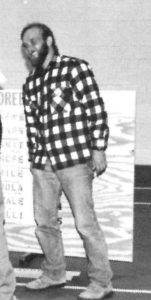

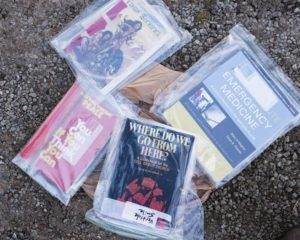

In mail communication with the runners before the race, Cantrell warned runners that Barkley would “bite them in the ass.” He taunted them with, “There is no way you’ll be finishing this race.” He mentioned the “Hell” section and wrote, “believe me, there aren’t four miles to compare to Hell anywhere on the planet.”
Furtaw previewed it with Cantrell and left this description, “Hell is an incredibly steep ascent that goes westward straight up the side of Frozen Head Mountain. I was amazed at the steepness of the climb. We had to literally pull ourselves uphill from tree to tree in the steepest places. I was astounded to see that there were paint blazes on some of the trees along the hill.” Cantrell explained that they were on an old mining trail used by the prisoners years ago.
Cantrell described Hell, “It starts with a cross-country effort that calls for not only an internal compass, but also an altimeter. On a mountain honeycombed with coal mines and coal roads, the failure to reach the 2600-foot bench buys the runner an opportunity to log miles of useless searching for the proper cutoff. Once the drop off is located, there is a steep drop of 1,000 feet.”
Eric Clifton
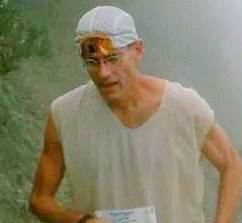

1988 Race details
With speedsters Possert and Clifton in the race, Cantrell gave Furtaw some pre-race advice to not play the guide role, let speedsters go on. If he did that, he thought Furtaw could both finish and win. That year the climbs totaled about 27,000 feet during the 55-60 miles. Again, there was a 36-hour cut-off.
Possert and Clifton flew around the first loop. Clifton finished in 5:50 with Possert arriving two minutes later. Furtaw finished in 6:54 and Pilon in 8:00. Seven runners became confused and missed one of the checkpoints. One more runner quit after “Hell.”
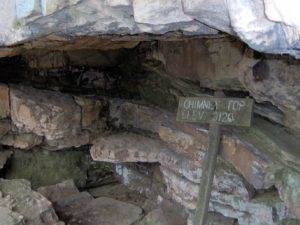

In all, eleven runners finished the first loop, but only six started loop two. The course was faster this year because the park had removed many blow-downs. During loop two, Possert and Clifton made a critical error, missing a short section to go to the top of Frozen Head again. They thought they didn’t need to summit on the last two loops but they misunderstood. Cantrell had said that they didn’t need to climb to the top of the tower on the last two loops. This was discovered later. Possert finished loop two first, followed by Clifton ninety minutes later who quit at that point, and Ed Furtaw an hour after that, in 15:09. While Possert was struggling with loop three, word came in to the start that he goofed on his second loop and he would repeat the mistake on this third loop, cutting the course distance by a total of about one mile.
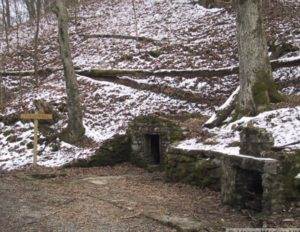

Out in the darkness, in fog and rain, Possert continued, not knowing that all his effort would result in a DNF. At 23:47, he finished his third loop as Ed Furtaw scrambled to start his third loop after a very long three-hour rest. Possert received the sad news that he had been disqualified and commented, “I know what I did and I’m satisfied with my effort. That was the hardest 24 hours I’ve ever experienced.” Cantrell commented, “His class in the face of bitter disappointment stands alone as the brightest moment that will ever be seen at the Barkley.” (There would be many much more disappointing moments in the years to come.) By dawn, Furtaw was the only one left on the course. After three years, Barkley finally had its first 55-mile finish! Furtaw came in at 32:14.
Furtaw later wrote, “As I approached the finish line, I was expecting a congratulatory crowd to greet me. However when I arrived at the campground, only Karl’s wife, Cathy Henn, and their two children were there.” Cantrell soon returned after retrieving the drop bags and presented Furtaw with the “Barkley Cup.”
In Cantrell’s report of the Barkley, commenting on the number of runners who went off course, he wrote, “The runner cannot afford to lapse into a semi-comatose state of pure running and suffering. Failure to stay alert for even a moment can lead to a wander off the trail and finding it again can be quite difficult.
Runners were of course curious that now that a runner successfully finished his course, would Cantrell make it harder. Cantrell announced that for 1989 there would be a 100-mile option with 50,000 feet of “wonderful climbing” with a 50-hour cut-off. He then taunted, after all, “two miles per hours ain’t much. I’m sure there are plenty of ‘real runners’ out there who believe they can do it. We’ll see.”
1989 Barkley


For 1989, Barkley was appropriately held on April Fool’s Day. The 55-mile version was referred to as “the short one” and the 100-miler, “the long one.” Rat Jaw, a new major climb was added to each loop that went up the south face of Frozen Head. If the runners cared about history, this route was interesting, taking them by the mine ruins and a mine guardhouse, which would be a book location for many years. The course came within a mile of Brushy Mountain Prison where James Earl Ray was still incarcerated. See Birth of the Barkley. The name “Rat Jaw” was based on what that section looked like on a map. The course remained the same from 1989-1994.
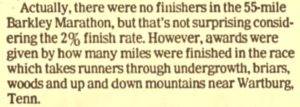

1990 Barkley
For 1990, the popularity of Barkley increased with 29 starters with many repeat victims. The race fee had increased to $1.55. For the first time the field included some international competition including famed race-walker, Uli Kamm from Germany. Barkley attracted some new elite runners.
David Horton
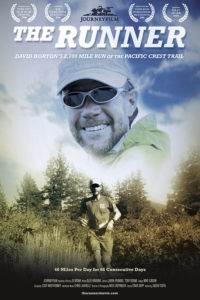

In 1983 he ran his first Western States 100. He had trained hard for it, running about 2,000 miles since the first of that year. It paid off. He finished in 9th place with a time of 18:39. In 1986 at the age of 36 he ran a blistering 100-mile time of 14:26 at Sri Chinmoy at Flushing Meadows coming in 3rd. By 1990 Horton’s slowest time in a 100-mile race up to that year was 22:05. Surly if anyone could be the first to conquer the Barley 100-mile long run, Horton could, right? Eric Clifton also ran again and elite runner David Drach came along too.
1990 Race Details
The fast runners headed out at the start, leading the pack. But because of foggy conditions these speedy “virgins” soon went off course and had a very hard time finding the first book. Furtaw, with his Barkley experience had no problem and was surprised to see at the first book that no pages had yet been torn out. Frozen Ed was in first place and continued to lead through the first two loops, finishing the first loop in a record 7:16 (for the 1989-90 course.) But he quit after loop two despite Cantrell’s prodding for him to continue.
Clifton went slower on the first loop, guiding his wife Shelby. When she quit after loop one, Clifton sped ahead and eventually caught up with Horton, Drach, and another runner on the second loop. The finished loop two together. Uli Kamm finished the second loop in a courageous 23:44. With swollen knees he wisely bowed out at that point.
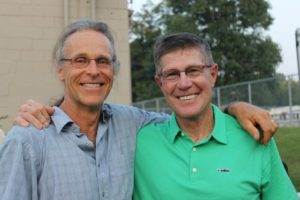

Horton, Clifton and Drach were the only ones to start loop three (of six) and finished loop three together in 26:22. They completed loop three in time to continue on for a fourth loop. Clifton went out to do 100 meters of loop four to claim the longest Barkley attempt ever. Horton was just waiting for his chance. With only seconds remaining to leave on loop 4, he went out and traveled 150 meters to claim the record. Horton later said, that his three-loop accomplishment at Barkley may have been his best ultra performance of his career. Most of the runners thought Cantrell six loop 100 was a joke and couldn’t be done. Horton said it was the toughest course in the world.
The First 100-mile Finisher
The 55-mile “fun run” version of Barkley would start to be figured out with ten finishers in 1991, two in 1992, eleven in 1993, and one in 1994. Many of the earliest finishers were smart people with PhD’s. There was a Swiss runner who broke his ankle during a loop and instead of taking the “quitters road” back had hopped on one leg for the rest of the loop.


In 1995 the loops were increased to 20 miles, making a three-lap “fun run” 60 miler. “Zip Line” and “Big Hell” were added to the course. The 100 miles, now the official Barkley finish, required five loops with a 60-hour cutoff. That year, Tom Possert was the first to complete the 60-mile fun run and said before he left for home that he didn’t think anyone would ever finish the 100. He should have stayed longer, because that year, Mark Williams, of the UK, a two-time finisher of Spartathlon, became the first to finish the full 100-mile version of the Barkley Marathons in 59:28:48. He would go on to finish Spartathlon 13 times, but finish Barkley, “only” once, along with a fun run in 1996.
When Williams finished, Horton came up to him and said, “now you have ruined it for everybody. I used to come here and try this, go as far as I could and then go home. I wouldn’t finish and thought it was impossible, but now that gone, it is possible.”
Barkley was now well-established and ready to crush the dreams of hundreds of runners in the years to come.
- Ultrarunning Magazine, 1986-1990
- Fertaw, Tales From Out There, 32
- “50 Hours of Hell: The Story of the Barkley Marathons”, Outside
- Sara Estes, “Good Luck, Morons: Lazarus Lake & His Impossible Race”
- The Tennessee Department of Environment and Conservation, “Tennessee State Parks — Frozen Head State Park.” Retrieved: 7 March 2008.
- The Bad Boy Running Podcast.
- Voice of Runners Podcast
- The Tennessean (Nashville), Oct 21, 1971, Oct 22, 1978, Nov 21, 1978, May 8, 1985, Apr 4, 1989, Feb 9, 1990
- The Leaf-Chronicle (Tennessee), Oct 24, 1952, Feb 8, 1973, Sep 6, 1978
